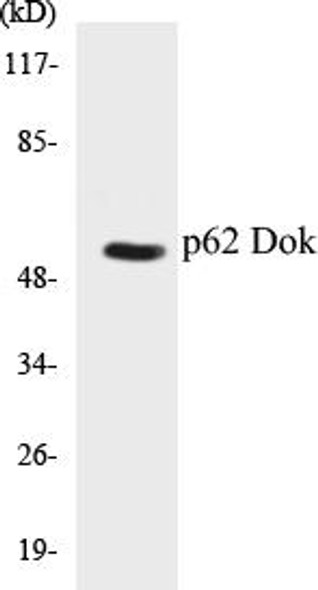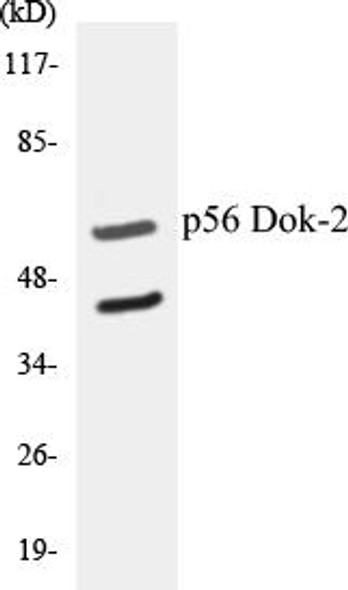Description
p62 Dok (Phospho-Tyr362)Colorimetric Cell-Based ELISA Kit
The p62/Dok Phospho-Tyr362 Colorimetric Cell-Based ELISA Kit from Assay Genie is designed for the accurate detection of phosphorylated p62/Dok (Tyr362) levels in cell lysates and tissue samples. This kit offers high sensitivity and specificity, ensuring precise and reliable results for your research needs.p62/Dok is a critical signaling molecule involved in various cellular processes, including cell growth, survival, and differentiation.
Phosphorylation of p62/Dok at Tyr362 plays a key role in regulating its function and has been implicated in diseases such as cancer, diabetes, and inflammatory disorders.With this ELISA kit, researchers can investigate the role of p62/Dok phosphorylation in cellular signaling pathways and disease pathogenesis, leading to a better understanding of disease mechanisms and the development of potential therapeutic interventions.
| Product Name: | p62 Dok (Phospho-Tyr362) Colorimetric Cell-Based ELISA |
| Product Code: | CBCAB01514 |
| ELISA Type: | Cell-Based |
| Target: | p62 Dok (Phospho-Tyr362) |
| Reactivity: | Human, Mouse, Rat |
| Dynamic Range: | > 5000 Cells |
| Detection Method: | Colorimetric 450 nm |
| Format: | 2 x 96-Well Microplates |
The p62 Dok (Phospho-Tyr362) Colorimetric Cell-Based ELISA Kit is a convenient, lysate-free, high throughput and sensitive assay kit that can detect p62 Dok protein phosphorylation and expression profile in cells. The kit can be used for measuring the relative amounts of phosphorylated p62 Dok in cultured cells as well as screening for the effects that various treatments, inhibitors (ie. siRNA or chemicals), or activators have on p62 Dok phosphorylation.
Qualitative determination of p62 Dok (Phospho-Tyr362) concentration is achieved by an indirect ELISA format. In essence, p62 Dok (Phospho-Tyr362) is captured by p62 Dok (Phospho-Tyr362)-specific primary (1ø) antibodies while the HRP-conjugated secondary (2ø) antibodies bind the Fc region of the 1ø antibody. Through this binding, the HRP enzyme conjugated to the 2ø antibody can catalyze a colorimetric reaction upon substrate addition. Due to the qualitative nature of the Cell-Based ELISA, multiple normalization methods are needed:
| 1. | A monoclonal antibody specific for human GAPDH is included to serve as an internal positive control in normalizing the target absorbance values. |
| 2. | Following the colorimetric measurement of HRP activity via substrate addition, the Crystal Violet whole-cell staining method may be used to determine cell density. After staining, the results can be analysed by normalizing the absorbance values to cell amounts, by which the plating difference can be adjusted. |
| Database Information: | Gene ID: 1796, UniProt ID: Q99704, OMIM: 602919, Unigene: Hs.103854 |
| Gene Symbol: | DOK1 |
| Sub Type: | Phospho |
| UniProt Protein Function: | DOK1: a docking protein that interacts with receptor tyrosine kinases. It is constitutively tyrosine phosphorylated in hematopoietic progenitors isolated from chronic myelogenous leukemia (CML) patients in the chronic phase. It may be a critical substrate for p210(bcr/abl), a chimeric protein whose presence is associated with CML. Docking protein 1 contains a putative pleckstrin homology domain at the amino terminus and ten PXXP SH3 recognition motifs. Docking protein 2 binds p120 (RasGAP) from CML cells. It has been postulated to play a role in mitogenic signaling. |
| UniProt Protein Details: | Protein type:Motility/polarity/chemotaxis; Adaptor/scaffold Chromosomal Location of Human Ortholog: 2p13 Cellular Component: perinuclear region of cytoplasm; cytoplasm; cytosol; nucleus Molecular Function:protein binding; receptor signaling protein activity; insulin receptor binding Biological Process: cell surface receptor linked signal transduction; Ras protein signal transduction; insulin receptor signaling pathway; signal transduction; transmembrane receptor protein tyrosine kinase signaling pathway |
| NCBI Summary: | The protein encoded by this gene is part of a signal transduction pathway downstream of receptor tyrosine kinases. The encoded protein is a scaffold protein that helps form a platform for the assembly of multiprotein signaling complexes. Two transcript variants encoding different isoforms have been found for this gene. [provided by RefSeq, Oct 2010] |
| UniProt Code: | Q99704 |
| NCBI GenInfo Identifier: | 17366642 |
| NCBI Gene ID: | 1796 |
| NCBI Accession: | Q99704.1 |
| UniProt Secondary Accession: | Q99704,O43204, Q53TY2, Q9UHG6, |
| UniProt Related Accession: | Q99704 |
| Molecular Weight: | 481 |
| NCBI Full Name: | Docking protein 1 |
| NCBI Synonym Full Names: | docking protein 1, 62kDa (downstream of tyrosine kinase 1) |
| NCBI Official Symbol: | DOK1 |
| NCBI Official Synonym Symbols: | P62DOK |
| NCBI Protein Information: | docking protein 1; pp62; p62(dok); Downstream of tyrosine kinase 1; docking protein 1 (downstream of tyrosine kinase 1) |
| UniProt Protein Name: | Docking protein 1 |
| UniProt Synonym Protein Names: | Downstream of tyrosine kinase 1; p62(dok); pp62 |
| Protein Family: | Docking protein |
| UniProt Gene Name: | DOK1 |
| UniProt Entry Name: | DOK1_HUMAN |
| Component | Quantity |
| 96-Well Cell Culture Clear-Bottom Microplate | 2 plates |
| 10X TBS | 24 mL |
| Quenching Buffer | 24 mL |
| Blocking Buffer | 50 mL |
| 15X Wash Buffer | 50 mL |
| Primary Antibody Diluent | 12 mL |
| 100x Anti-Phospho Target Antibody | 60 µL |
| 100x Anti-Target Antibody | 60 µL |
| Anti-GAPDH Antibody | 60 µL |
| HRP-Conjugated Anti-Rabbit IgG Antibody | 12 mL |
| HRP-Conjugated Anti-Mouse IgG Antibody | 12 mL |
| SDS Solution | 12 mL |
| Stop Solution | 24 mL |
| Ready-to-Use Substrate | 12 mL |
| Crystal Violet Solution | 12 mL |
| Adhesive Plate Seals | 2 seals |
The following materials and/or equipment are NOT provided in this kit but are necessary to successfully conduct the experiment:
- Microplate reader able to measure absorbance at 450 nm and/or 595 nm for Crystal Violet Cell Staining (Optional)
- Micropipettes with capability of measuring volumes ranging from 1 µL to 1 ml
- 37% formaldehyde (Sigma Cat# F-8775) or formaldehyde from other sources
- Squirt bottle, manifold dispenser, multichannel pipette reservoir or automated microplate washer
- Graph paper or computer software capable of generating or displaying logarithmic functions
- Absorbent papers or vacuum aspirator
- Test tubes or microfuge tubes capable of storing ≥1 ml
- Poly-L-Lysine (Sigma Cat# P4832 for suspension cells)
- Orbital shaker (optional)
- Deionized or sterile water
*Note: Protocols are specific to each batch/lot. For the correct instructions please follow the protocol included in your kit.
| Step | Procedure |
| 1. | Seed 200 µL of 20,000 adherent cells in culture medium in each well of a 96-well plate. The plates included in the kit are sterile and treated for cell culture. For suspension cells and loosely attached cells, coat the plates with 100 µL of 10 µg/ml Poly-L-Lysine (not included) to each well of a 96-well plate for 30 minutes at 37 °C prior to adding cells. |
| 2. | Incubate the cells for overnight at 37 °C, 5% CO2. |
| 3. | Treat the cells as desired. |
| 4. | Remove the cell culture medium and rinse with 200 µL of 1x TBS, twice. |
| 5. | Fix the cells by incubating with 100 µL of Fixing Solution for 20 minutes at room temperature. The 4% formaldehyde is used for adherent cells and 8% formaldehyde is used for suspension cells and loosely attached cells. |
| 6. | Remove the Fixing Solution and wash the plate 3 times with 200 µL 1x Wash Buffer for five minutes each time with gentle shaking on the orbital shaker. The plate can be stored at 4 °C for a week. |
| 7. | Add 100 µL of Quenching Buffer and incubate for 20 minutes at room temperature. |
| 8. | Wash the plate 3 times with 1x Wash Buffer for 5 minutes each time. |
| 9. | Add 200 µL of Blocking Buffer and incubate for 1 hour at room temperature. |
| 10. | Wash 3 times with 200 µL of 1x Wash Buffer for 5 minutes each time. |
| 11. | Add 50 µL of 1x primary antibodies Anti-p62 Dok (Phospho-Tyr362) Antibody, Anti-p62 Dok Antibody and/or Anti-GAPDH Antibody) to the corresponding wells, cover with Parafilm and incubate for 16 hours (overnight) at 4 °C. If the target expression is known to be high, incubate for 2 hours at room temperature. |
| 12. | Wash 3 times with 200 µL of 1x Wash Buffer for 5 minutes each time. |
| 13. | Add 50 µL of 1x secondary antibodies (HRP-Conjugated AntiRabbit IgG Antibody or HRP-Conjugated Anti-Mouse IgG Antibody) to corresponding wells and incubate for 1.5 hours at room temperature. |
| 14. | Wash 3 times with 200 µL of 1x Wash Buffer for 5 minutes each time. |
| 15. | Add 50 µL of Ready-to-Use Substrate to each well and incubate for 30 minutes at room temperature in the dark. |
| 16. | Add 50 µL of Stop Solution to each well and read OD at 450 nm immediately using the microplate reader. |
(Additional Crystal Violet staining may be performed if desired – details of this may be found in the kit technical manual.)






